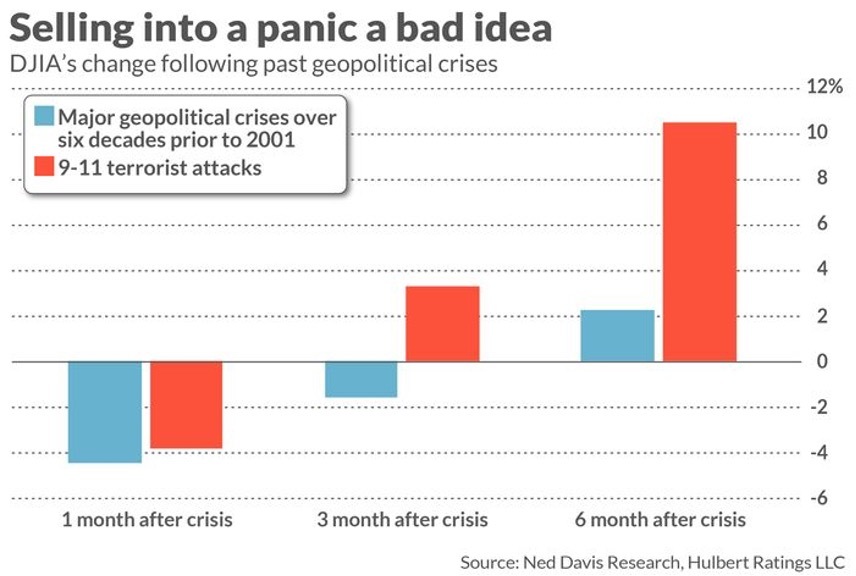 The world watches Ukraine with bated breath...
The world watches Ukraine with bated breath...
We're sure the idea of "living in unprecedented times" is becoming a tiring one for many of you. It might feel like a once-in-a-generation event is happening once in a quarter.
In the past four months, we've had another resurgence in the coronavirus pandemic with the omicron variant, and we've seen central banks globally rattling their interest rate sabers and spooking markets. And now, after a multiweek build-up, the war in Ukraine officially became a "hot" war this week.
Amid all this uncertainty, the S&P 500 Index is now off more than 12% from its highs earlier in the year, and the Nasdaq Composite is flirting on and off with being down 20%, into dreaded "bear market" territory.
We don't blame you for naturally wondering how you should be positioning your portfolio in such uncertainty...
 Even amid scary headlines, a focus on data helps us understand if we should stay the course...
Even amid scary headlines, a focus on data helps us understand if we should stay the course...
When trying to figure out how to react to events like this, we believe that process helps us conquer our emotions. It is why we regularly talk about the research that we've done on market cycles each week. If we can identify patterns and be systematic, we don't need to panic. We can go back to a safe touchstone to keep us balanced and take rational action.
At the beginning of the pandemic in March 2020, we shared a powerful table that put the pandemic in context. It showed how the market performed during different pandemics and epidemics over the last several decades.
The data showed that the severity of the epidemic wasn't what drove the market six months or 12 months later. Rather, the market conditions going in were far more important.
We saw a great chart from Ned Davis Research that highlights a similar insight for geopolitical events. It was so perfect we couldn't help but share it.
While unrest in the market may concern investors right now, the reality is it doesn't materially affect market performance long term.
Ned Davis Research looked at major geopolitical events from the past 80 years, such as events like the conflict between Russia and Ukraine.
According to the research, on average, six months after the geopolitical crisis first occurred, the market was at a higher level than when the news first broke. There's a dispersion, of course, but thanks to general economic tailwinds, the real power behind the market, stocks tend to trend higher.
When the markets reopened following the attacks on 9/11, the stock market dropped 17.5% lower than it was on September 10. However, within six months, it was trading at more than 10% higher than when it closed the day before the attacks.
The market has been under pressure for close to a month based on the developments in Ukraine. While instincts may push people to sell their holdings now that Russia has pushed into Ukraine, history shows us that it is usually on the wrong side of the trade.
 Zeroing in on what matters for the market, we aren't concerned about the market...
Zeroing in on what matters for the market, we aren't concerned about the market...
So now that we know not just to panic because of headlines, how should we react based on the data?
A look back at what we've been saying the past few months can help you understand why we think this is a compelling buying opportunity for investors in the market.
Corporations are starting to grow more bullish about investing. An increase in capital expenditures ("capex") tells us that management teams are willing to invest in essential equipment that will make them more resilient and capable of dealing with supply chain disruptions. This capex boom can act as a major tailwind for companies across all industries.
We're finally seeing commercial and industrial (C&I) loan growth accelerating.
While the market reacts poorly when the Federal Reserve starts raising rates, investors are missing that the Fed is raising rates because it considers the economy to be on a firmer footing. This signals that the economy is starting to pick up again.
Aggregate cost to borrow remains low. Companies can easily access credit markets to refinance or borrow to invest, helping maintain growth. Companies currently have plenty of room to continue to grow and refinance without overly increasing debt burdens.
People are spooked about inflation. But when you look at it with a long-term view, the type that should impact valuations, we see that inflation expectations remain anchored in a way that doesn't threaten corporate multiples or disrupt the market.
So, while people are glued to the stories covering Ukraine, they will be focused on another geopolitical story in a few months.
The reality is if you follow the data and a sound process, you know there is no reason to sell.
Time and time again, we have seen people panic in geopolitical crises... but history has shown the best thing to do is stay the course.
Regards,
Joel Litman and Rob Spivey
February 25, 2022
P.S. We covered much of today's discussion yesterday in our Timetable Investor monthly report.
Our Altimetry subscribers not only gain access to our Uniform Accounting data for more than 5,000 companies but also get access to our monthly review of the current macro environment through the Timetable Investor.
If you want to receive our monthly macro insights on how to position your portfolio and be in the know on which stocks are compelling amid the panic in Eastern Europe, sign up for access right here.



 The world watches Ukraine with bated breath...
The world watches Ukraine with bated breath...


